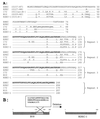Complete nucleotide sequence and analysis of the locus of enterocyte Effacement from rabbit diarrheagenic Escherichia coli RDEC-1
- PMID: 11254564
- PMCID: PMC98136
- DOI: 10.1128/IAI.69.4.2107-2115.2001
Complete nucleotide sequence and analysis of the locus of enterocyte Effacement from rabbit diarrheagenic Escherichia coli RDEC-1
Abstract
The pathogenicity island termed the locus of enterocyte effacement (LEE) is found in diverse attaching and effacing pathogens associated with diarrhea in humans and other animal species. To explore the relation of variation in LEE sequences to host specificity and genetic lineage, we determined the nucleotide sequence of the LEE region from a rabbit diarrheagenic Escherichia coli strain RDEC-1 (O15:H-) and compared it with those from human enteropathogenic E. coli (EPEC, O127:H6) and enterohemorrhagic E. coli (EHEC, O157:H7) strains. Differing from EPEC and EHEC LEEs, the RDEC-1 LEE is not inserted at selC and is flanked by an IS2 element and the lifA toxin gene. The RDEC-1 LEE contains a core region of 40 open reading frames, all of which are shared with the LEE of EPEC and EHEC. orf3 and the ERIC (enteric repetitive intergenic consensus) sequence present in the LEEs of EHEC and EPEC are absent from the RDEC-1 LEE. The predicted promoters of LEE1, LEE2, LEE3, tir, and LEE4 operons are highly conserved among the LEEs, although the upstream regions varied considerably for tir and the crucial LEE1 promoter, suggesting differences in regulation. Among the shared genes, high homology (>95% identity) between the RDEC-1 and the EPEC and EHEC LEEs at the predicted amino acid level was observed for the components of the type III secretion apparatus, the Ces chaperones, and the Ler regulator. In contrast, more divergence (66 to 88% identity) was observed in genes encoding proteins involved in host interaction, such as intimin (Eae) and the secreted proteins (Tir and Esps). A comparison of the highly variable genes from RDEC-1 with those from a number of attaching and effacing pathogens infecting different species and of different evolutionary lineages was performed. Although RDEC-1 diverges from some human-infecting EPEC and EHEC, most of the variation observed appeared to be due to evolutionary lineage rather than host specificity. Therefore, much of the observed hypervariability in genes involved in pathogenesis may not represent specific adaptation to different host species.
Figures



Similar articles
-
Characterization of the eaeA gene from rabbit enteropathogenic Escherichia coli strain RDEC-1 and comparison to other eaeA genes from bacteria that cause attaching-effacing lesions.FEMS Microbiol Lett. 1996 Nov 1;144(2-3):249-58. doi: 10.1111/j.1574-6968.1996.tb08538.x. FEMS Microbiol Lett. 1996. PMID: 8900070
-
Locus of enterocyte effacement from Citrobacter rodentium: sequence analysis and evidence for horizontal transfer among attaching and effacing pathogens.Infect Immun. 2001 Oct;69(10):6323-35. doi: 10.1128/IAI.69.10.6323-6335.2001. Infect Immun. 2001. PMID: 11553577 Free PMC article.
-
The Per regulon of enteropathogenic Escherichia coli : identification of a regulatory cascade and a novel transcriptional activator, the locus of enterocyte effacement (LEE)-encoded regulator (Ler).Mol Microbiol. 1999 Jul;33(2):296-306. doi: 10.1046/j.1365-2958.1999.01473.x. Mol Microbiol. 1999. PMID: 10411746
-
Interkingdom Chemical Signaling in Enterohemorrhagic Escherichia coli O157:H7.Adv Exp Med Biol. 2016;874:201-13. doi: 10.1007/978-3-319-20215-0_9. Adv Exp Med Biol. 2016. PMID: 26589220 Review.
-
Impact of the locus of enterocyte effacement pathogenicity island on the evolution of pathogenic Escherichia coli.Int J Med Microbiol. 2004 Sep;294(2-3):103-13. doi: 10.1016/j.ijmm.2004.06.024. Int J Med Microbiol. 2004. PMID: 15493820 Review.
Cited by
-
Protection of rabbits against enteropathogenic Escherichia coli (EPEC) using an intimin null mutant.BMC Vet Res. 2006 Jun 23;2:22. doi: 10.1186/1746-6148-2-22. BMC Vet Res. 2006. PMID: 16796739 Free PMC article. Clinical Trial.
-
Characterization of Shiga toxin-producing Escherichia coli strains isolated from human patients in Germany over a 3-year period.J Clin Microbiol. 2004 Mar;42(3):1099-108. doi: 10.1128/JCM.42.3.1099-1108.2004. J Clin Microbiol. 2004. PMID: 15004060 Free PMC article.
-
Comparative sequence analysis of the plasmid-encoded regulator of enteropathogenic Escherichia coli Strains.Infect Immun. 2001 Sep;69(9):5553-64. doi: 10.1128/IAI.69.9.5553-5564.2001. Infect Immun. 2001. PMID: 11500429 Free PMC article.
-
Genetic diversity of intimin genes of attaching and effacing Escherichia coli strains.J Clin Microbiol. 2002 Dec;40(12):4486-92. doi: 10.1128/JCM.40.12.4486-4492.2002. J Clin Microbiol. 2002. PMID: 12454140 Free PMC article.
-
Citrobacter rodentium lifA/efa1 is essential for colonic colonization and crypt cell hyperplasia in vivo.Infect Immun. 2005 Mar;73(3):1441-51. doi: 10.1128/IAI.73.3.1441-1451.2005. Infect Immun. 2005. PMID: 15731042 Free PMC article.
References
-
- Abe A, de Grado M, Pfuetzner R A, Sanchez-Sanmartin C, Devinney R, Puente J L, Strynadka N C, Finlay B B. Enteropathogenic Escherichia coli translocated intimin receptor, Tir, requires a specific chaperone for stable secretion. Mol Microbiol. 1999;33:1162–1175. - PubMed
-
- Agin T S, Cantey J R, Boedeker E C, Wolf M K. Characterization of the eaeA gene from rabbit enteropathogenic Escherichia coli strain RDEC-1 and comparison to other eaeA genes from bacteria that cause attaching-effacing lesions. FEMS Microbiol Lett. 1996;144:249–258. - PubMed
-
- An H, Fairbrother J M, Dubreuil J D, Harel J. Cloning and characterization of the eae gene from a dog attaching and effacing Escherichia coli strain 4221. FEMS Microbiol Lett. 1997;148:239–245. - PubMed
Publication types
MeSH terms
Substances
Grants and funding
LinkOut - more resources
Full Text Sources
Other Literature Sources
Medical

